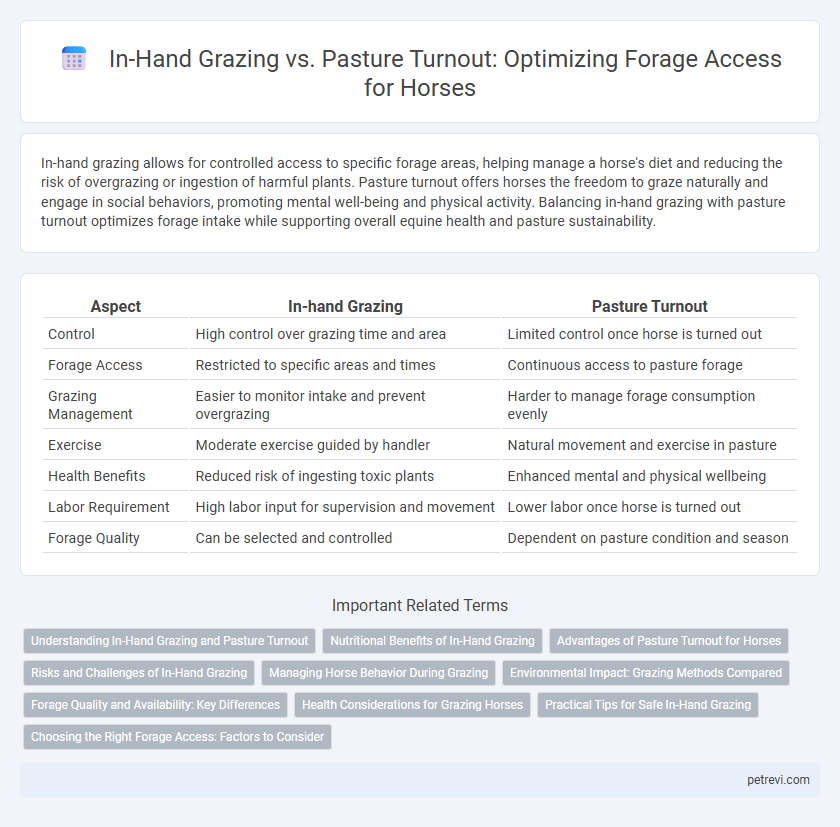In-hand grazing allows for controlled access to specific forage areas, helping manage a horse's diet and reducing the risk of overgrazing or ingestion of harmful plants. Pasture turnout offers horses the freedom to graze naturally and engage in social behaviors, promoting mental well-being and physical activity. Balancing in-hand grazing with pasture turnout optimizes forage intake while supporting overall equine health and pasture sustainability.
Table of Comparison
| Aspect | In-hand Grazing | Pasture Turnout |
|---|---|---|
| Control | High control over grazing time and area | Limited control once horse is turned out |
| Forage Access | Restricted to specific areas and times | Continuous access to pasture forage |
| Grazing Management | Easier to monitor intake and prevent overgrazing | Harder to manage forage consumption evenly |
| Exercise | Moderate exercise guided by handler | Natural movement and exercise in pasture |
| Health Benefits | Reduced risk of ingesting toxic plants | Enhanced mental and physical wellbeing |
| Labor Requirement | High labor input for supervision and movement | Lower labor once horse is turned out |
| Forage Quality | Can be selected and controlled | Dependent on pasture condition and season |
Understanding In-Hand Grazing and Pasture Turnout
In-hand grazing allows precise control over a horse's forage intake by guiding the horse to specific areas, reducing overgrazing and managing diet quality effectively. Pasture turnout offers horses free access to a natural grazing environment, promoting natural behaviors but requiring careful pasture management to prevent uneven forage consumption. Balancing in-hand grazing with pasture turnout optimizes forage utilization while supporting equine digestive health and preventing obesity.
Nutritional Benefits of In-Hand Grazing
In-hand grazing allows precise control over the horse's forage intake, promoting a balanced diet tailored to specific nutritional needs and reducing the risk of overconsumption or ingestion of harmful plants. This method facilitates the selection of high-quality forage, ensuring optimal nutrient absorption such as vitamins, minerals, and fiber essential for digestive health. Targeted grazing sessions support weight management and prevent metabolic disorders by providing consistent, measured access to nutrient-dense pasture.
Advantages of Pasture Turnout for Horses
Pasture turnout provides horses with continuous access to fresh forage, promoting natural grazing behavior and enhancing digestive health. Exposure to natural sunlight during turnout supports vitamin D synthesis, which is vital for bone strength and immune function. Social interaction with other horses during pasture turnout reduces stress and encourages mental well-being.
Risks and Challenges of In-Hand Grazing
In-hand grazing for horses poses risks such as limited natural forage availability and increased stress from restricted movement, which can lead to behavioral issues and digestive problems. Horses may also experience uneven grazing patterns, resulting in inadequate nutrient intake and overgrazing of small areas. Managing in-hand grazing requires careful monitoring to prevent laminitis, colic, and frustration due to the lack of natural roaming compared to pasture turnout.
Managing Horse Behavior During Grazing
Effective management of horse behavior during grazing is essential for optimizing forage intake and minimizing conflicts in both in-hand grazing and pasture turnout scenarios. In-hand grazing allows for controlled access to specific forage areas, reducing the risk of overgrazing and supporting targeted nutrition, while pasture turnout requires careful monitoring to prevent dominant horses from monopolizing resources. Implementing strategic rotation and using barriers or halters can help balance social dynamics and encourage equitable forage access among herd members.
Environmental Impact: Grazing Methods Compared
In-hand grazing minimizes environmental impact by controlling horse movement, reducing overgrazing and soil compaction compared to pasture turnout, which allows unrestricted access and can lead to uneven forage depletion and increased soil erosion. Rotational in-hand grazing promotes healthier pasture regrowth and biodiversity, supporting sustainable land use and reducing nutrient runoff into waterways. Conversely, continuous pasture turnout often results in degraded land quality and higher maintenance costs due to uneven grazing pressure and soil damage.
Forage Quality and Availability: Key Differences
In-hand grazing allows controlled access to high-quality forage, minimizing overgrazing and promoting selective feeding, which enhances nutrient intake. Pasture turnout offers horses unrestricted access to varied forage species, but forage quality may decline due to trampling and uneven grazing patterns. Managing forage availability involves balancing these methods to optimize nutrient consumption and maintain pasture health.
Health Considerations for Grazing Horses
In-hand grazing offers controlled forage access that minimizes risks of overeating and digestive disturbances such as colic or laminitis, especially in horses prone to metabolic issues. Pasture turnout allows horses more natural movement and social interaction, beneficial for musculoskeletal health and mental well-being but requires diligent pasture management to prevent overgrazing and ingestion of harmful plants. Regular veterinary monitoring and tailored grazing strategies can optimize digestive health, weight management, and overall welfare in grazing horses.
Practical Tips for Safe In-Hand Grazing
Safe in-hand grazing requires using a well-fitted halter and lead rope to maintain control while allowing the horse to nibble selectively on high-quality forage. Choose grassy areas free of toxic plants, holes, or debris to prevent injury and ingestion of harmful substances. Limit grazing time to avoid overconsumption and monitor the horse's behavior closely to recognize signs of discomfort or digestive upset.
Choosing the Right Forage Access: Factors to Consider
Choosing the right forage access for horses involves evaluating factors such as the quality and type of forage, the horse's dietary needs, and the management goals of the stable. In-hand grazing allows precise control over intake, reducing the risk of overconsumption and promoting selective grazing, while pasture turnout provides natural movement and social interaction but may increase exposure to parasites and uneven forage availability. Consideration of pasture condition, horse behavior, and nutritional requirements is essential to optimize health and ensure sustainable forage use.
In-hand Grazing vs Pasture Turnout for Horse Forage Access Infographic

 petrevi.com
petrevi.com